
Babylon's Fall is on track to be Square Enix's next GaaS blunder
If you don’t remember, Babylon’s Fall has been cooking in the oven ever since its initial announcement at E3… 2018. On paper, it looked to be another exciting collaboration between PlatinumGames and Square Enix; after all, their previous project together was NieR: Automata. At that time, Babylon’s Fall looked like another stylish single-player character action game now set in a medieval fantasy setting. After many delays in its seemingly troubled development, the nature of Babylon’s Fall was finally unveiled at E3 2021.
Babylon’s Fall would be a live games-as-a-service title focusing on multiplayer co-op.
A strange turn to many initial expectations, but I was still curious. Sure, its re-reveal could have been better; the trailer shown this past E3 was rough, messy, and unpolished. Perhaps Babylon’s Fall was one of those games that felt better to play than it was to watch. I finally got my hands on it during Phase 3 of the Closed Beta Test, which is supposedly the most polished version of the game yet after implementing feedback from the previous two phases.
I’ll be upfront and honest before I break down what I played. After spending over two hours with two friends diving into this for the first time, we all came to the same conclusion. We never wanted to play this ever again.
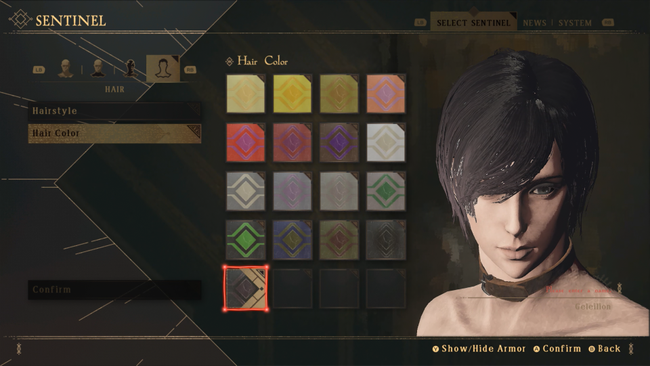
Upon starting Babylon’s Fall, I was greeted by a character creator asking which of the following three races I wanted to be: a Huysian, Agavian, or a Geleilion. They come with some flavor text of where they reside and their trade, but the real meat of what distinguishes them are their Gideon Coffin abilities. In early footage of Babylon’s Fall, we’d often see a character fling themselves toward an enemy with a tether, and that seems to be the Huysian’s Soul Vault skill for its Gideon Coffin. Meanwhile, an Agavian can drain life from a tethered foe and a Gelelion gradually weakens those that are tethered to them.
Other than that, it’s a standard character creator that provides options for body type, hair style, hair color, skin color, eye color, and so on. The brushwork filter that encompasses Babylon’s Fall graphical engine does no favors for its character models up close. It gives off the sensation of an in-progress oil painting; the harsh light source resembles rasterized Rembrandt lighting in an uncanny way. Of course, this aspect could very well be one of many elements that remain in progress and may be improved in the final game.
When I was satisfied with my short-lived character, I found myself in some sort of hub area moments later. No tutorials, no explanation of anything that’s happening, nothing besides the tooltip in the two-second loading screen that said Sentinel HQ; I awkwardly looked around for a few minutes trying to grasp what to do. There were other random live people running around this home base doing their own thing. I figured out the two most important places of interest soon enough - the shopkeeper and the mission board; I would later find a NPC tucked away that was in charge of daily quests because those seem mandatory for live games.
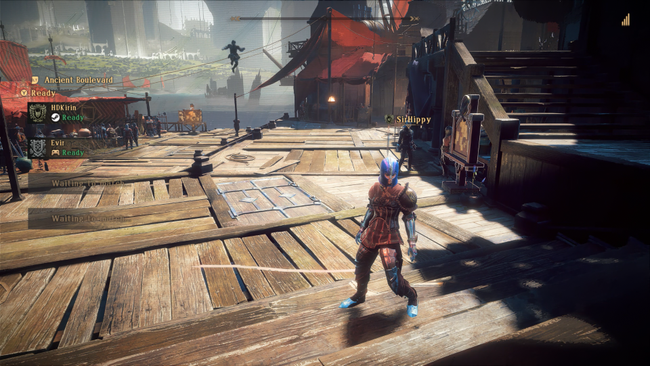
Think of the Sentinel HQ as the village in Monster Hunter. In order to start quests, I had to approach the mission board, select a stage, and post it up. People in the same lobby instance can choose to join it once it’s posted. For this closed beta test, there was no easy way to directly invite friends to the same Sentinel HQ. One of us had to identify our Sentinel HQ ID and have others input that code to enter that friend’s lobby. I played Babylon’s Fall on PC, while my two other friends were on their Playstation 5 consoles. Cross-play was supported and that seemed to work well enough with no issues.
Once I posted up the mission and my two friends joined, we all readied up… and waited. There seemed to be no way to initiate a mission immediately until the final slot was taken up or awkwardly waiting around for roughly 30-45 seconds for the game to finally recognize that some slots would remain vacant. Another fun fact is that once you ready up, there’s no way to un-ready yourself either.
Stages in Babylon’s Fall are as bog-standard as they come. In the brief time I’ve spent with it, I played three stages that all shared the exact same environment of some sort of castle or shrine ruins all linearly laid out to run from one battle arena to the next. There would sometimes be a chest off the beaten path or environmental interactions, such as swinging over spikes or running through window corridors. The only thing that truly distinguished the initial three stages I played were different time-of-day and weather effects.
Despite these gripes, surely the combat would deliver, right? This is PlatinumGames we’re talking about after all.
Remember how 2B’s sword floated behind her in NieR: Automata? Babylon’s Fall aims to strike a similar vibe to that, except each character can equip a whopping four weapons that all float behind them as they’re connected to a device bolted on their back through thin red threads. In the closed beta, I was able to test out a one-handed sword, a hammer, a wand, a bow, and a shield. Each weapon slot can all use a different type of weapon, but the placement of where you slot them in matters. Players can either place them in their primary light and heavy attack slots corresponding to the square and triangle buttons, or the spirit weapon slots, assigned to the L2 and R2 buttons.
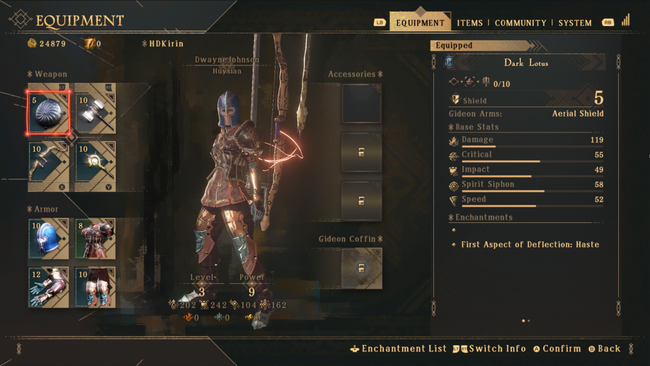
The light and heavy attack strings are simple enough to understand. Light weapon strings can be comboed into heavy weapon strings seamlessly. On the other hand, spirit weapons consumed a separate red gauge beneath my health bar. Think of this as your MP gauge and each press of L2 or R2 will expend a bit of it.
Some weapons operate somewhat similarly in a light/heavy attack slot as they would in a spirit weapon slot, such as one-handed swords; they still swing swiftly in their spirit forms, although now in mid-air. Shields, on the other hand, operate quite differently between the different types of slots. In a light/heavy weapon slot, they’ll be fishing for well-timed parries against incoming attacks, while spirit weapon shields hold down the corresponding button to put up a spectral barrier to defend the character as it gradually consumes MP.
MP regeneration happens very slowly unless players are privy to which kinds of weapons refill them at a decent rate. Repeated light or heavy attack strings seem to be the play early on to regen them, but different weapon types accumulate MP at differing rates. One-handed swords, for example, are pitiful compared to bows in regenerating MP and hammers are decent siphons at the cost of a slower attack speed.
This leads to interesting strategic considerations on how I wanted to carve out my playstyle. Two builds I was fond of were 1.) a hammer as my heavy attack aided by a spirit shield and 2.) a bow as my light attack paired with a spirit hammer. The former could relentlessly bash on the hammer button taking minimal damage thanks to the spirit shield and the hammer would constantly regenerate the mana expended by keeping the shield up. Meanwhile, the latter focused on being a close-range archer that primarily used the spirit hammer as it main means of dealing damage as the bow would quickly refill the MP to continually bonk foes again and again.
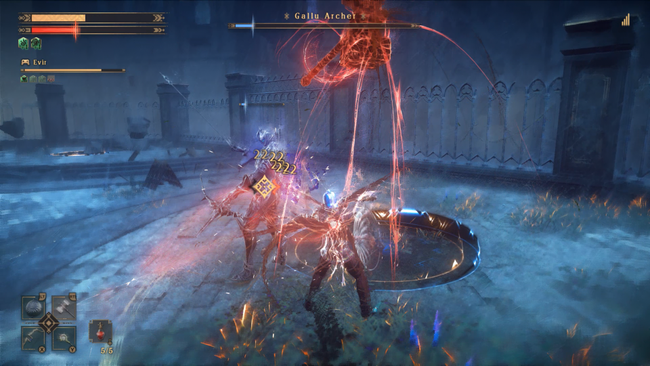
Other signature PlatinumGames combat systems are in place, like a dedicated dodge button. Dodging does consume a bit of MP though and yes, you can dodge at any time instantly in the middle of attack strings. Perfect dodges are in place to give a brief window of opportunity to counter attack, and each encounter does rank players individually based on their performance all the way up to the coveted Pure Platinum medal of honor. Enemies can be launched into the air with some weapons, and a dedicated jump button can keep combos going mid-air. Players can simply choose to keep juggling them from the ground with repeated arrow shots too.
I’m sure some of you may be thinking this sounds great on paper. I would agree. It does sound great on paper. In practice though… not as much as I’d hope.
Enemies are often damage sponges with more health than you’d expect. They don’t react to hits unless it’s a huge incoming attack, like a charged up hammer strike. The MP gauge feels too restrictive and you can only fire off so many spirit attack combo strings until it goes from full to empty in mere moments, so my friends and I had to go through the tedious process of charging it up to a decent amount to fire off 1 or 2 spirit attacks only to go through the vicious cycle again.
If we wanted to experiment with a new weapon layout, we would have to commit to it until the very end of the level because there was no way to alter them once the level started. Anything we picked up in the middle of the level remained unidentified until we reached the finish, and only after victory could we see the spoils of battle. Yes, rarity levels are all color-coded.
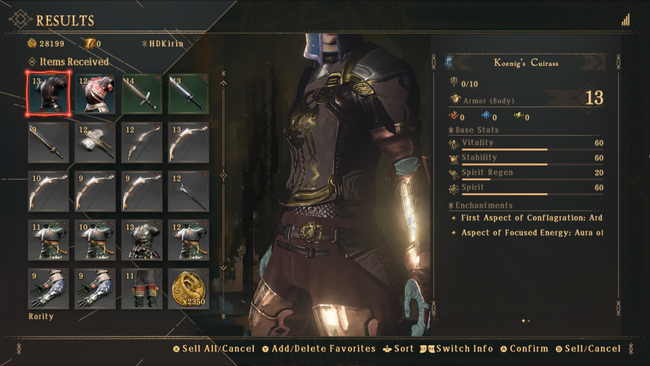
Combat, in general, just felt clunky and didn’t flow as well as I would have liked. It’s nowhere near as smooth as NieR: Automata, Bayonetta, and the recent NieR Replicant re-release. Hell, even Anarchy Reigns feels better than Babylon’s Fall because the impact of hits had that satisfying oomph that enemies reacted to, which Babylon’s Fall sorely lacks.
We didn’t even make it far enough in the closed beta test to see how the Gideon Coffin mechanic works, if it even exists at the moment. There’s a strange difficulty curve that spikes after the third stage. Each of them presents a recommended power level to let players know how tough they can expect it to be. The first three stages have recommended power levels of 1, then 4, and then 7. Seems fine enough with a gradual ramp up. Then all of a sudden, the fourth level has a recommended power level of 20. As we hopped into that, our damage numbers just took a nosedive off Mount Everest. The highest gear we had up until that point had a power rating of 13, maybe 14, at most. Were we expected to just… grind earlier stages in hopes of getting better equipment to tackle it? We all agreed that we had better uses of our time.
Another fun discovery in Phase 3 of Babylon’s Fall’s closed beta test is the clunky way of selling gear you didn’t want. One would hope that there would be a ‘Sell All’ option at the shopkeeper to instantly, well, sell all the gear your character didn’t have equipped instantly. Instead, players had to hold the sell button for about two seconds on each and every single piece of equipment you did not want; yes, one by one.
Thankfully, there is a method to make this process faster as long as players know where to look. After a mission ends and you appraise all the unidentified loot they picked up, you have to make sure to mark the equipment you want to keep as favorites, and then click the ‘Sell All’ button that is only available at that screen.
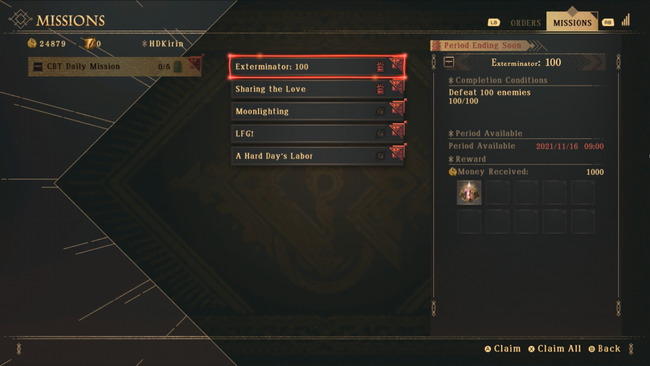
Babylon’s Fall has the potential to be a decent multiplayer action game, but PlatinumGames and Square Enix have a lot of work to get it where it needs to be by the time it launches. If this third closed beta test is indicative of what to expect at launch, I imagine my friends and I won’t be the only ones sharing a similar first impression. As I mentioned earlier, the battle system sounds great on paper, but it is way slower and clunkier than it should be. Enemies aren’t necessarily difficult to deal with, but they take way too long to extinguish at the moment. The lack of hitstun and reaction to hit impacts diminishes the feeling of what should be a great battle system.
Its structure as a games-as-a-service model feels needless as well. I would much rather have a sprawling single-player character action game with RPG progression systems over grinding linear stages over and over again in the hopes of raising my gear score to tackle more difficult stages, in which I’ll inevitably have to do that cycle again. The aesthetic of the level design suffers for it too, with many reused layouts already rampant and apparent in the early stages alone.
Babylon’s Fall feels like a product built on top of irony after the recent Square Enix 2021 Annual Report. President Yosuke Matsuda highlighted the performance of another recent games-as-a-service product from Square Enix, known as Marvel’s Avengers. Here is what he had to say.
Marvel’s Avengers was an ambitious title for us that we took on the GaaS (Games as a Service) model. We overcame a variety of unexpected difficulties in the final phase of the game’s development, including needing to transition to work-from-home due to the pandemic. We were able to surmount these challenges and release the game, but it has unfortunately not proven as successful as we would have liked. Nonetheless, taking on the GaaS model highlighted issues that we are likely to face in future game development efforts such as the need to select game designs that mesh with the unique attributes and tastes of our studios and development teams. While the new challenge we tackled with this title produced a disappointing outcome, we are certain that the GaaS approach will grow in importance as gaming becomes more service oriented.
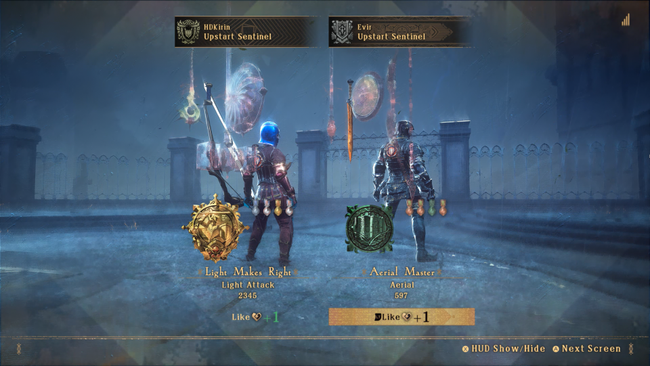
So far, Babylon’s Fall seems to be the antithesis of Matsuda’s statement; very little of its game design at the moment seems to come together, and I’m left unsure if PlatinumGames is the right fit for this kind of model.
I wish I had more positive things to say about Babylon’s Fall. Its music was sometimes ok, I guess, but that’s because it’s trying real hard to be like NieR: Automata at those times, and trying to be that game’s music isn’t a bad thing.